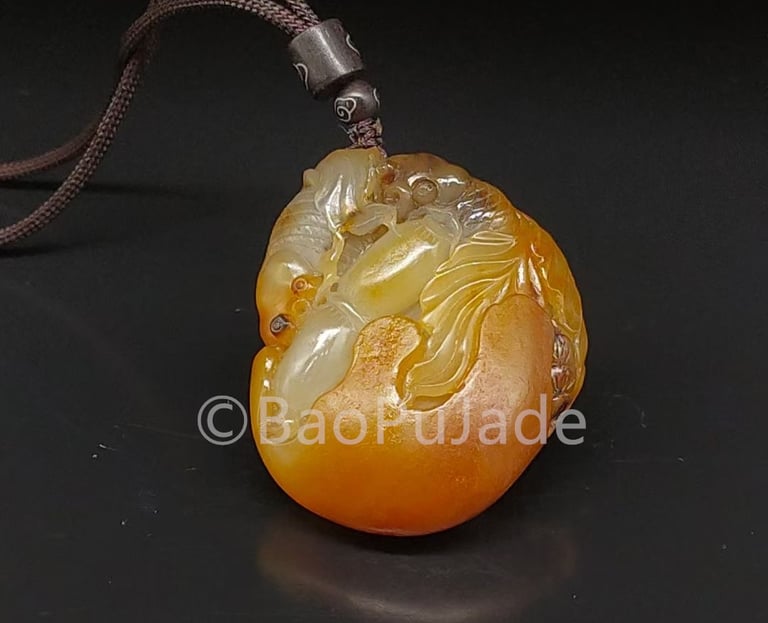Our brand's only official website is: baopujade.com (Beware of counterfeit sites!)
In-depth Analysis of the Impact of Jade on Feng Shui
So, how to choose which jade to wear or place in your home?
FENG SHUI
Rimbaud
2/28/20253 min read


In Feng Shui, jade has always played an important role. It can safeguard the home against evil spirits, regulate emotions, and even, under specific circumstances, adjust Feng Shui to enhance wealth. Additionally, wearing jade jewellery for long periods of time can also have the benefits of beautifying the skin, enhancing one's temperament, and massaging acupoints to promote blood circulation.
However, different types of jade represent different elemental properties, and even the same type of jade can have different effects in Feng Shui depending on factors such as processing methods, carving styles, and wearing techniques.
In Wu Xing(usually known as Five Elements theory in Western Feng Shui culture, it refers to five elements: Jin, Mu, Shui, Huo, and Tu), jades associated with the element of Jin(usually known as Metal in Western Feng Shui culture, it possesses characteristics of both flexibility and firmness, extension, transformation, and solemnity) are typically linked with white, yellow, or golden hues, symbolizing clarity, brightness, and cleanliness. For instance, in Xinjiang, Jinsi jade includes varieties like Mutton-fat White, Ice-yellow, Sugar-white, High-ice, Snow-green, Ice-green, yellow-coloured jade, Gem Light Jinsi Jade, etc.
In Wu Xing, jades associated with the element of Mu(usually known as Wood in Western Feng Shui culture, Mu possesses the gentle and benevolent qualities of flexibility, resilience, and upward growth) are often linked to concepts of growth and development, particularly with shades of green. For example, Xiu jade, jasper, green jadeite, snow-green and ice-green varieties in Jinsi jade, Dongling jade, and Qinghua (bluish-green) in Hetian jade are all representative of this association.
In the Five Elements theory, jades associated with the element of Shui(usually known as Water in Western Feng Shui culture, it possesses the characteristic of moisturizing and descending, as well as the ability to delve into and conceal) are typically linked with shades of blue, black, or white. Some jades are formed through the impact of water during their formation process. For example, Hetian jade pebbles formed in water, ink Hetian jade, blue or ink-colored varieties in Jinsi jade, Gem Light Jinsi Jade, and sky-blue jadeite are all representative of this association.
In Wu Xing, jades associated with the element of Huo (usually known as Fire in Western Feng Shui culture, it has the characteristics of warmth and upward growth, as well as the functions of dispelling cold, insulation, and exercising metals)are typically linked with red and yellow hues, related to the characteristics of jade formed by the cooling of underground magma. For example, red and yellow varieties in Jinsi jade, Gem Light Jinsi Jade, Hetian jade pebbles, and Huang Loong jade are representative of this association.
As for jades associated with the element of Tu(usually known as Earth in Western Feng Shui culture, it possesses the ability to carry, nurture, and store, serving as the mother of all things, exhibiting the characteristics of contributing and being substantial), they are the most common attribute in jade. They are connected to earth-toned colours and the solid, stable quality of jade. Essentially, all jades contain a certain amount of Tu attribute.
So, how to choose which jade to wear or place in your home?
To select the right jade for yourself, first determine your own elemental attributes. Figure out which element you belong to, what element you lack, and the preferred elemental attributes according to the Ba Zi system. Then, choose the jade that suits you best. For example, if someone was born on the eighth day of the third lunar month in the Chinese calendar in 2024, he belongs to the Huo element. When considering Zhi Cang, this person lacks the Huo element; without considering Zhi Cang, this person lacks the Shui element. However, his Ri Yuan is overly strong, favouring the Huo and Mu elements but avoiding using the Jin and Tu elements. Therefore, in this case, this person would be more suitable to wear jades with Huo and Mu attributes, such as red and yellow varieties in Jinsi jade, Gem Light Jinsi Jade, Hetian jade pebble, jadeite, snow-green and ice-green varieties in Jinsi jade, Dongling jade, and Qinghua (bluish-green) in Hetian jade.
How to choose what jade to place in your home? Determine where to place different types of jade based on the orientation of your home.
For instance, according to the Ba Zhai Feng Shui system, if your home is a Kun Mansion, meaning it faces northeast and sits southwest, and if your master bedroom happens to be located in the north (Kan), falling into the "death position" (which corresponds to the Po Jun Star, an inauspicious star associated with the Metal element that could lead to instability and decline in household fortune), then you may consider placing jades with Water or Earth attributes in your bedroom. Examples include Hetian jade pebbles formed in water, Ink Hetian jade, blue or ink-colored varieties in Jinsi jade, Gem Light Jinsi Jade, and sky-blue jade.
*Ba means Eight and Zhai means Mansion.
The above examples are provided for reference only, as residential Feng Shui positioning and the circumstances of the homeowner are quite complex. Different analyses need to be conducted based on different situations, so this article will not delve into extensive explanations.
Please note: This article is original to the brand BaoPuJade. Reproduction is prohibited and any infringement will be prosecuted.
BaoPuJade
info@baopujade.com
rimbaudzhu@gmail.com
Postal code: 830094
Address: Area A-32, 1st Floor, Erdaoqiao Grand Bazaar, No. 127 Tianchi Road, Tianshan District, Urumqi City, Xinjiang Uygur Autonomous Region
Newsletter sign-up
Our brand's only official website is:
baopujade.com
(Beware of counterfeit sites!)
© 2023-2025. All rights reserved.
